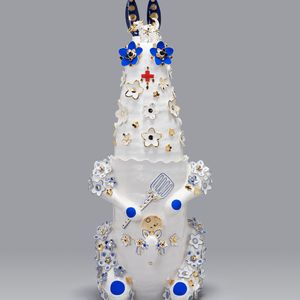Skippy and the Dog
Skippy and the Dog inspired by Rebeca's story, 2024
Ceramic and mixed media
$22,000
To capture Rebeca’s story, Vipoo created a large kangaroo-inspired deity. The deity holds a spatula reflecting Rebeca’s love of cooking. On its head is a golden vomit dog with a small bird, in Llort’s style, offering moral support. The deity’s pouch contains a joey with a halo made from Rebeca’s broken plates, representing new beginnings, resilience and protection.
REBECA'S STORY
My name is Rebeca. I came to Australia from El Salvador 36-years ago and I've lived in Brisbane since then. I've travelled around Australia a lot and I love this country.
After arriving in Australia, I did a Bachelor of Arts with a major in graphic design. Twenty years ago, I changed my career, and now I am a paediatric nurse. One of my hobbies is pottery; it’s what I do to relax.
It was a long process to get here from El Salvador. We were in the middle of the war so within 6 months I got an interview with an Australian delegate, and I was approved. I then needed to have lots of medical tests. In 1986 October I was in the middle of a medical test when we had a big earthquake. That delayed me another 6 months, so all up it took a year. I became a citizen after being here for 2 years.
What did you feel about moving to Australia?
In the 80s, there was a civil war in El Salvador and so life was very unstable. Australia was one of the countries assisting people to come to live. Since I was a little girl, I had wanted to come to Australia as I always read about Australia’s fauna and flora and thought it was very exotic. When I was growing up, we had a TV show, “Skippy the Bush Kangaroo”, so I became obsessed. When I had to choose where to go in 1986, I chose Australia with a humanitarian visa. That program has finished now.
I thought I was coming to the outback and instead I came to a big city. Although I was familiar with the American accent, I couldn't understand anything people were saying in Australia. I knew how to read and write English, but I found speaking and conversation difficult.
I was taken to a hostel where we were introduced to Australian culture and had English lessons. We lived in a community where there were many people fleeing conflicts in their countries – Polish, Hungarians, Czechoslovakian and more. It was an interesting time, but as soon as I saw the country, I knew I liked it.
I had left my family, but I think because my dream as a little girl was to come to Australia that helped me to stay here. Back in 1987, Australia had all the resources. We were looked after in this little town of migrant people and refugees, and that worked. Unfortunately, that doesn't exist anymore, so I was lucky.
I didn't have too much difficulty with the language and so it was easy for me to get into Queensland College of Art, one year after arriving. I think all that helped me.
What advice would you give to someone moving to Australia?
We are very privileged living here because Australia is one of the countries that remains in peace, and the quality of life is good here as we all have the same opportunities. I encourage people overseas to apply because it’s life changing. I also tell them that it's difficult to make the sacrifice of leaving your family.
Now there is peace in El Salvador and the program has finished, so for us to come now it’s really difficult. It’s also hard to find our food here. We use a lot of Vietnamese and Thai ingredients. It's very strange how Asian food is similar to what we eat in Central America. Although the process is different, the ingredients are the same. Australia has a big multicultural community, and we can rely on that.
What Australian culture do you love?
I love the environment, the flora, the animals, the landscapes. I like going to the beach and the beautiful countryside. I really love how Australians protect the environment. I was impressed to learn about indigenous aboriginal culture when doing my degree at the Queensland College of Art; their legacy to us and their art. I went to Uluru and that was something special.
OBJECT
In 1992, 5 years after I left, I returned to El Salvador. I was fascinated with the El Salvador National Artist Fernando Llort who worked in communities, giving workshops in all the little towns. He was very unselfish, not only giving his art to them, but teaching them how to make it, so that they could produce it too. This art is now part of El Salvador’s culture. I was influenced by his stylistic depiction of animals, trees, and houses, so I made four little ceramic plates using my own stylised carvings of a bird, the sun and the moon. I brought them here to Australia as they reminded me of the Salvadoran spirit of hope, optimism and resilience.
Two of the four plates broke when I started cooking for my dog. Sadly, I didn't know he was allergic to many things. He got really sick, and I slipped on his vomit on the floor, falling against the wall where the plates were hanging. Two of the plates fell down and broke, but I couldn't throw them away as they were so special.
Image top: Vipoo Srivilasa, Skippy and the Dog , 2024 Photo: Simon Strong





